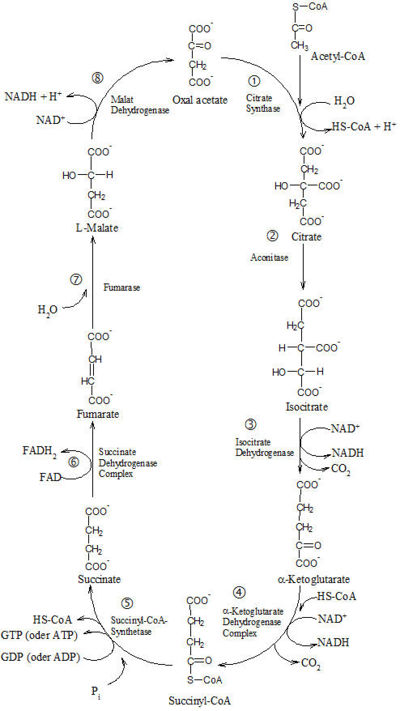Krebs cycle overview
From Proteopedia
The Krebs cycle - an overview
The entire citric acid cycle (see figure) as a final common pathway of degradation of the nutrients is introduced into citrate by the condensation reaction of oxaloacetate (C4 ) and acetyl -CoA. Here, acetyl-CoA releases its acetyl group (C2) that froms the C6-body citrate by reacting with oxal acetate. This reaction is catalyzed by the enzyme citrate synthase. In the second step, catalysed by the enzyme aconitase, citrate is transformed into isocitrate. The subsequent reaction, catalysed by isocitrate dehydrogenase, is an oxidative decarboxylation, wherein the first CO2 molecule is released and accordingly, the C5-body α-ketoglutarate is formed. The second oxidative decarboxylation reaction takes place in the next step, in which the product succinyl-CoA is formed. Since this reaction also releases a molecule of CO2, succinyl-CoA is a C4-body.
After the first half of the Kreby cycle, two molecules of CO2 are released out of citrate. the second half of the Krebs cycle serves as preparation: Succinyl-CoA is transformed via four steps into oxal acetate that can react again with acetyl-CoA to start the cycle again: In the fifth reaction, succinyl-CoA transformed to succinat. Afterwards, succinate looses two protons to form fumarate, a molecule with a double bond. The reaction of fumarate to L-malate (step 6) is a hydration reaction: Therefore, a hydrogen atom is replaced by an OH group within two steps (from succinate to L-malate). In the last reaction , oxal acetate is regenerated.
Overall, the entire Krebs cycle can be summarised by the following equation:
Acetyl-CoA + 3 NAD+ + FAD + GDP (or ADP) + Pi + 2 H2O → HS-CoA + 3 NADH + FADH2 + GTP (or ATP) + 2 CO2 + 2 H+
- The discovery of the Krebs cycle
- The importance of the Krebs Cycle in the metabolism
- First step: Citrate Synthase
- Second Step of the krebs Cycle: Aconitase
- Step three of the Krebs Cycle: Isocitrate Dehydrogenase
- Step four of the Krebs Cycle: α-Ketoglutarat Dehydrogenase
- Step 5 of the Krebs cycle: Succinyl-CoA Synthetase
- Step 6 of the Krebs cycle: Succinate Dehydrogenase
- Step 7 of the Krebs cycle: Fumarase
- Step 8 of the Krebs cycle: Malat-Dehydrogenase
- The way of the carbon atoms in the Krebs cycle
- Reactions related with the Krebs cycle
- Major metabolic pathways converging on the citric acid cycle
- Citric acid cycle intermediates serve as substrates for biosynthetic processes
Proteopedia Page Contributors and Editors (what is this?)
Karsten Theis, Jaime Prilusky, Verena Pietzner, Alexander Berchansky

